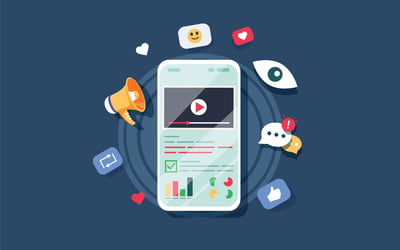October 22, 2019
 by Andrej Kovačević / October 22, 2019
by Andrej Kovačević / October 22, 2019

For a long time, the marketing efforts of major brands had one big thing in common: they were aimed squarely at an overwhelmingly older, white, male audience.
At the time, that made sense, as they represented the majority of the consumer market. Today, however, that kind of approach is not only outdated, but it can also harm a brand.
First, it ignores the changing reality of today's market.
As of this year, millennials now make up the largest living generation in the United States (and elsewhere), and are coming into their prime spending years. That's a big shift that carries some important consequences for marketers.
According to Deloitte, Millennials are the most diverse generation in history, which means that today's marketers can no longer craft the kind of narrowly-targeted campaigns that worked in the past.
They're also a generation that values inclusion as a key factor in their purchasing decisions, with a whopping 70 percent claiming they'll choose one brand over another based on the inclusion and diversity displayed by the brand's promotions and offers.
That means it's imperative for today's marketers to embrace a concept that's now known as diversity marketing.
Here's an overview of diversity marketing, some strategies that marketers can use to make it the focus of their ongoing efforts, and a few examples of companies who've done it right.
At its core, the concept of diversity marketing is simple.
Diversity marketing involves recognizing and including various subgroups within your target audience while staying informed about cultural and societal changes in your community and among your customers. It is rooted in the belief that diverse perspectives inspire more innovative ideas and strategies, setting the foundation for effective and inclusive marketing campaigns.
Within those groupings, it's also possible to further segment the market using factors like marital status, weight, educational attainment, income, and occupation.
In short, diversity marketing is a means of hyper-targeting a marketing campaign in a way that will connect with the widest variety of people within a target market.
In today's global marketplace, there are more types of marketing than ever before. There are online channels like email marketing, content marketing, and affiliate marketing. Then, there are traditional offline methods like print and television advertising, direct mail, and telemarketing.
Diversity marketing, however, does not refer to the mode of the message delivery. Instead, it's an umbrella term that describes the intent and motivation of the content of a marketing message.
A diversity marketing effort can and should consist of a variety of messaging channels, including those mentioned above. What sets it apart from other strategies is that the specific messaging is fine-tuned for the audience it's trying to reach and is delivered to the target group via their preferred communication channels.
To work, diversity marketing must be data-driven, authentic, and culturally aware. When it's not, the message can fall flat.
That's what happened to global fashion brand Dolce & Gabbana, that did tremendous damage to its brand with a social media video campaign aimed at the Chinese market.
In the videos, an Asian model is seen eating traditional Italian foods with chopsticks, with varying degrees of success. The videos were posted on Chinese social media network Weibo and caused widespread outrage, as they seemed to depict Chinese people as uncultured and inferior.
In that case, the company picked the right messaging channel, Weibo, which reaches nearly a quarter of China's 1.3 billion residents. The message itself, however, was inauthentic, ill-conceived, and culturally insensitive.
Therein lies the main challenge of diversity marketing. When done well, it can help a brand communicate with its target audience in a way that feels familiar and is, therefore, effective. When done poorly, it can backfire spectacularly.
As is the case with many other types of marketing, there's no single "right way" to develop a diversity marketing campaign.
Instead, they must develop organically to fit each specific case and require marketers to adopt a number of overall strategies to make that happen. Here's what they are.
To create authentic messaging for a diverse market, your creative team must first reflect the market you're trying to reach.
It's an important first step, and one that can't be overstated. To do it, embrace diversity hiring practices in building your marketing team to provide the kinds of voices that will be vital in crafting messages that resonate.
Strive to build diversity in the workplace by crafting a team that includes the backgrounds, philosophies, and beliefs of those you're trying to market to – and solid diversity marketing will flow from it.
One of the most important things a marketer can do to develop an effective diversity marketing campaign is understand the subgroup they're talking to inside and out.
The key to doing that is to collect as much data as possible and use modern data analytics techniques to extract meaningful insights. Deploy a variety of tactics to get the most accurate picture you can and never ignore what the data reflects.
For example, a simple focus group test would have prevented Dolce & Gabbana's Chinese campaign disaster, and some more comprehensive market research may have revealed a better approach.
|
TIP: Today, there's no shortage of marketing technologies (also known as martech) that can provide critical market insights to inform diversity marketing efforts, and it pays to use them. Learn all about the marketing field is using artificial intelligence to boost message power and reach. |
A common pitfall in diversity marketing is the tendency to create a unified brand message, and then adapt it to fit each new target group. That kind of cut-and-paste approach will almost always fail. Instead, organic messaging should be unique for each group, recognizing it's specific needs, desires, and connection with the brand.
In creating diversity marketing campaigns, it's important to know the audience you're speaking to, but it's also critical to create messaging that doesn't exclude others.
Doing that requires a detailed understanding of the ways that the language used in a campaign can have the unintended side effect of creating barriers or propagating unconscious biases.
To avoid that, make sure to use inclusive language in all aspects of each campaign to make it both target-specific and welcoming to others. Better yet, learn how to craft a diversity statement that you can use to showcase the efforts you, as a company, are making.
One of the best ways to ensure authenticity in a diversity marketing campaign is to allow the customers you're targeting to have a voice in it.
That means collecting and listening to customer feedback during and after the execution of each campaign to either validate or challenge the effort.
Whenever possible, it's also a great strategy to empower customers to create content that provides an honest reflection of what the brand means to them.
Doing so not only provides a valuable source of real-world data you can use for future campaigns, but also serves as powerful messaging that's sure to resonate with others in the target market.
So far, we've only touched on a single example of diversity marketing, and it's the one with a poor outcome.
It's instructive, however, to take a look at some examples of diversity marketing done to perfection to provide some insight into how powerful a marketing strategy can be.
There is perhaps no better example of diversity marketing done right than Coca-Cola's America is beautiful campaign that began in 2014.
The associated advertising included a culturally and racially diverse cast singing a multi-language rendition of the song, "America the Beautiful."
The ads, which began with an airing during the Super Bowl that year, prompted a dialogue about the changing face of America and how the brand represented a cultural touchstone that's shared by all.
Another prime example of diversity marketing in action is the Guinness campaign "Friendship," which began in 2013.
In the associated television ad, a group of men is depicted playing a spirited (and physically demanding) game of wheelchair basketball. At the end, all but one of the players stands up from their chairs, revealing that they'd played the game to include a wheelchair-bound friend.
The ad was a perfect example of an inclusive marketing message, and was a top-performing advertisement at the time it aired.
Some examples of diversity marketing illustrate how a brand can boldly identify with a target subgroup in ways that its competition either won't or can't. Chevrolet's The New Us campaign in 2014 was a perfect example of that concept.
Aimed at the LGBT community, it was the first auto ad in the United States to associate LGBT families with a major brand. It was hailed as a breakthrough in diversity marketing at the time and led to a one-point gain in favorability for the brand in the target demographic.
| Related: Read more about LGBT marketing efforts that support and uplift the community, and what examples you can take year-round. |
As the current generation comes to dominate consumer spending, it's clear that diversity marketing is going to become an essential strategy for marketers and brands alike.
Without it, it's going to become impossible to connect with consumers in ways that will motivate them to become loyal customers and brand ambassadors in the future.
Now is the time to start making diversity marketing a centerpiece of future planning and begin to implement some of the strategies covered here to support the effort. It's a worthwhile endeavor for any brand, and one that will pay dividends for many years to come.
Interested in learning more about all types of marketing and how to execute them well and to your company's advantage? Check out our knowledge hub chock full of over 50 incredible resources to help you get started.
Andrej is a digital marketing expert, editor at TechLoot, and a contributing writer for a variety of other technology-focused online publications. He has covered the intersection of marketing and technology for several years and is pursuing an ongoing mission to share his expertise with business leaders and marketing professionals everywhere.
There have been many articles written about utilizing GIFs in marketing.
 by Steve Rado
by Steve Rado
You've come up with a fresh business idea, created a new product, or rebranded an old one.
 by Anna Konovalova
by Anna Konovalova
Ever wonder why some brands feel everywhere, from your morning news feed to the billboard you...
 by Soundarya Jayaraman
by Soundarya Jayaraman
There have been many articles written about utilizing GIFs in marketing.
 by Steve Rado
by Steve Rado
You've come up with a fresh business idea, created a new product, or rebranded an old one.
 by Anna Konovalova
by Anna Konovalova


